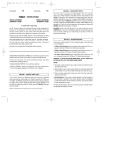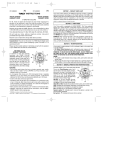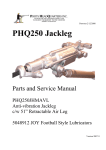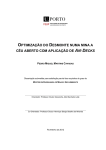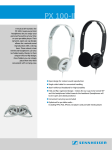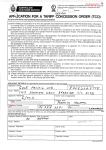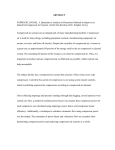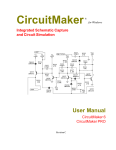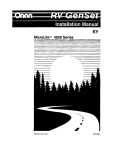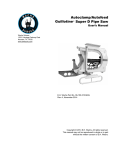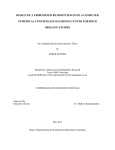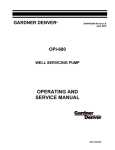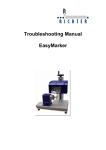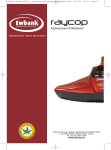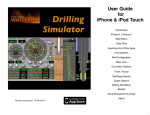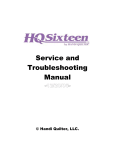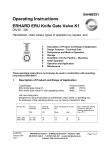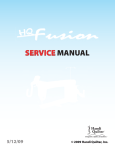Download Drilling with Air
Transcript
By John L’Espoir V Drilling with Air Airspeed of 35 mph is required, while foam can just have its own pace. What makes a screw compressor and piston machine work? What is DTHH drilling? elocity is the most critical part of drilling with air in the direct circulation method. Air is compressed and forced to the bottom of the hole through the drill pipe and expands at the bit to near atmospheric pressure, blowing upward in the annulus to get out. Along the way, it will blow formation chips, water, and other hole occupants out of this hole. Please note that I did not use the word “carry.” Air does not carry chips. Chips will fall because of gravity. An upward air velocity that is equal to the fall speed will balance that chip. A higher velocity will blow it out of the hole at 34 to 58 mph. This equates to 3000 to 5000 fpm annular uphole velocity for air drilling. The formula is easy: (D 2 – d 2) × 16.5 = cfm D = bit size in inches d = O.D. of flush joint pipe in inches cfm = required cfm to get 3000 fpm velocity. then a 750 cfm compressor will be required. Actual uphole velocity at 100% efficiency will be 750 ÷ 721 × 3000 = 3120 fpm. Yes, hole-cleaning time before connection is still a requirement. Drilling at a depth of 500 feet, the chip flying time will be 500 ÷ 3120 × 60 seconds = 10 seconds. As soon as you cut off the air supply, the chips start falling down. Many drillers will have one or more compressors and typically a 4½-inch flush joint pipe is used. Do not use a square shoulder tool joint style drill pipe for air drilling. (See “Drill Pipe and Collar Designs,” April 2009 Water Well Journal, page 54, for more information.) The question arises: Just how big a hole can I drill? (D 2 – d 2) × 16.5 = cfm converts into D = √ (d 2 + cfm ÷ 16.5). For direct circulation air drilling without foam, consider Table 1 as “gospel.” Many drillers brag on drilling larger holes with their compressor. Some of them will have enough integrity to call me and say: “John, I hate to admit that you were right. We are stuck bad, how can I get my hammer out?” My suggestions were: ● Get one or more compressors to get at least 5000 ft/min velocity. TRANSFER OF TECHNOLOGY/continues on page 40 Figure 1. Many drill manuals include this chart to determine compressor size. We prefer our simple formula. For example, what compressor is needed to drill an 8-inch air hole with 4½-inch O.D. pipe? ● ● ● D=8 d = 4.5 (82 – 4.52) × 16.5 = 721 cfm. If no air escapes into the formation, John L’Espoir has enjoyed a 40-year career in portable drilling equipment design. He holds a bachelor of science degree in mechanical engineering and was formerly the director of engineering for the George E. Failing Co. in Enid, Oklahoma. John was born in the Netherlands and moved to Enid in 1969. He is the founder, owner, and president of Enid Drill Systems Inc. He received the 2003 NGWA Technology Award. 38/ September 2010 Water Well Journal NGWA.org Table 1 Maximum Diameters for Some Popular Compressor Sizes, Using 41⁄2-Inch Pipe cfm d Inch D-Max Inch 1 71⁄8 71⁄2 81⁄8 81⁄2 85⁄8 91⁄8 95⁄8 101⁄2 117⁄8 131⁄8 141⁄4 500 600 750 850 900 1050 1200 1500 2000 2500 3000 4 ⁄2 41⁄2 41⁄2 41⁄2 41⁄2 41⁄2 41⁄2 41⁄2 41⁄2 41⁄2 41⁄2 Figure 2. Conventional three-cone bits. Courtesy of GT Engineering, Shawnee, Oklahoma. TRANSFER OF TECHNOLOGY/from page 38 ● ● ● ● Mix water/foam and try to float the chips out. Get a duplex pump to pump the hole clean. Get a crane large enough to pull your pipe past the breaking point and hope that it breaks close to the bit. Fill the hole properly and start over. The uphole velocity is strictly a function of the volume of the compressor in cfm. The compressor capacity is expressed as cfm/psi (900/350). Please be aware that the cfm is the intake cfm and not the volume at the rated pressure. Atmospheric pressure equals 14.7 psi. At 100% efficiency, ignoring altitude, humidity, and temperature, the compressed package would be 900 × 14.7 ÷ 350 = 37.8 cfm. Figure 3. The down-the-hole hammer: (a) downstroke-drill position; (b) upstroke-exhaust position. Courtesy of Numa. Threaded Connection Backhead Case Feed Tube Piston Air Pressure As stated previously, the compressed air is forced to either the button bit tricone or the DTHH (down-the-hole hammer). The hammer does not eat the air; it simply takes the energy stored in it, and then turns it loose into the borehole. Obstructions in the annular space, usually chips and water, will maintain some pressure on the air, reducing this as it comes to the top of the hole. 1 foot of water = 2.31 psi. This is for clean, fresh water without any kinds of solids. If the hole fills up with formation water while making a 40/ September 2010 Water Well Journal Blow Tube Bit Bearing Chuck Bit connection, the compressed air must have enough pressure to overcome this “hydrostatic” water column. Example: ● Rig shuts down for lunch. ● ● ● Hole fills up with 460 feet of water. Compressor is rated at 125 psi. When putting the air to the pipe, no circulation is noticed. NGWA.org Figure 4. (a) 350 cfm/220 psi deformed the kelly when using a DTHH. Both sub and kelly required remachining. This was a tight connection. (b) The spindle on the Dresser T70W is being ground down before the seal retainer can be removed. Swelling was caused by 750/250 DTHH without a shock sub. So, 460 ÷ 2.31 = 199 psi. A larger compressor is needed, with reference to the pressure rating—250 psi would break the water column, blow out the water, and drilling continues. An experienced driller will not shut down for lunch; however, if the situation described in the example happens for some reason, he would then pull 200 feet of pipe and try again. The water column would now be 260 feet above the bit or hammer (260 ÷ 2.31 = 112 psi). The 125 psi compressor would break the water pressure and blow out the water. Quick connections and blowing after each joint will get that bit back to the bottom of the hole to continue air drilling. Before selecting a compressor, the pressure must be considered for: ● ● ● Pressure required by the downhole hammer Maximum water column to be expected in the hole Cleaning of the bit. TRANSFER OF TECHNOLOGY/continues on page 42 Figure 5. (a) Design A; (b) Design B; (c) Design C. Courtesy of NHM (North Houston Machine). (a) NGWA.org (b) (c) Water Well Journal September 2010 41/ Table 2 LeRoi Air Compressor Model 256 S2C Figure 6. The LeRoi 250 series S2 (two stage) and SDS (single dual stage) are found on many rigs for well developing (three cylinder models) and drilling with air (six cylinder series). Courtesy of Comp Air. rpm hp Capacity (cfm) 870 125 445 1000 156 510 TRANSFER OF TECHNOLOGY/from page 41 Penetration Rate Figure 7. Schematic diagram of the air flow through compressor. Courtesy of Comp Air. Flow Control Valves 42/ September 2010 Water Well Journal Let’s look at two basic but different types of air drilling: conventional with collars and button type tricones, and down-the-hole jackhammer (known as DTHH drilling). The conventional three-cone bits (Figure 2) for hard formation are either a short tooth type or a tungsten carbide button tooth. A lot of drill collar weight is required to get proper chipping action. Weight of up to 8000 pounds per inch of diameter may be needed. An 8-inch hole would require 8 × 8000 = 64,000 pounds of drill collars. Add the drill pipe to get the string load and it becomes obvious that a rig with a minimum hookload of 100,000 pounds is required. Air drills are not this big and most rigs would have trouble putting more than 30,000 pounds of pulldown onto the string due to their limited rig rear axle weight. The DTHH is nothing more than a jackhammer operated by air to get chisel action at a slow rotary speed. A typical air drill will have a very slow rotary speed. Years ago, the hammers commonly used required 0 to 10 rpm and 250 psi. With the introduction of the variable speed hydrostat drives, the rpm has a range from 0 to 125 rpm, whereas the compressors have jumped from 250 to 300 to 350 to 450 to 500 psi. How high will this go? In 2001, I worked on a well rehabilitation project requiring 4200 psi. The air compressor was rated at 5000 psi. The psi in a hammer determines the energy of the blow to the bit (chisel). A 5-pound hammer could be seen as 125 psi making 350 psi like a sledgehammer. Downhole hammer suppliers came right along with better steels, better tolerances, and better lubrication to use these higher pressures. Rig manufacturNGWA.org Figure 8. Typical piping diagram rig application. Courtesy of Comp Air. energy hammers back into the drill stem. Air rigs do not typically use more than one or two drill collars. Pulldowns are used to maintain pressure on the bit. The reaction force energy will hammer this pipe, up and up, right into the topdrive or swivel/bearings. With bigger hammers, we see more premature bearing failures. Kelly and topdrive spindles are hammered so badly that the material swells (Figure 4). The Shock Sub Figure 9. Model 256 S2C installed on a Ewbank M-100-C operating in the Sahara Desert, Egypt. ers promptly modified designs to get more horsepower, bigger trucks, bigger PTOs and drives to get these larger compressors on board. As a side effect, the rigs became much larger and much more expensive. Coupling a highpressure mobile compressor to your old rig will have the same hammer performance. The DTH Hammer The downhole hammer (Figure 3) is a highly machined close tolerance machine tool. It will perform to predetermined cfm, psi, and lubrication. The NGWA.org piston has air grooves and channels to direct the compressed air to either push the piston up or blast it full speed down to impact on the bit shank. It is this impact shock on the buttons that fractures the rock formation. When specifying a hammer, please know what bit size and compressor will be used. Please keep sand and dirt from getting inside your drill pipe and pumping into the hammer, and do not forget the lube system. A bigger hammer and more air pressure will result in a bigger blow. Penetration rate will increase. What happens to the hammer reaction force? This To minimize the damage and isolate this reaction force, our industry has developed a series of subs (Figure 5). Design A: This design is the most effective. It is installed directly above the hammer and isolates the reaction energy. Drill pipe connections do not hammer up or swell the tool joints. Shown in Figure 5 is a 9-inch O.D. shock sub. Design B: This design is installed directly below the topdrive and is cushioned only in the pulldown mode. This flotation-type sub is used to let the lower part move up as a pipe is unscrewed. It is very popular on rigs with carousels, and keeps the hammer out of your topdrive bearings and hydraulics. Design C: This design is fully cushioned for both pulldown or holdback applied drilling. It can either be a pure shock sub as shown, or two cushions can be taken out to get 2 inches flotation. It is installed below the topdrive. Take note that a typical shock sub mounted below the topdrive will have a box-down connection to meet a pin-up drill pipe. The author does not know of any advantage to pin-up or pin-down drill pipes. Shock subs are available for pindown drill pipe as well as many different sizes of threads. NHM is currently fabricating a 22-inch-diameter sub to be installed behind a 32-inch Numa hammer. All shock sub designs must perform the following duties: 1. Transmit full rotary torque. 2. Transmit full mast hookload capacity. 3. Seal air at maximum psi and temperature. 4. Isolate the reaction energy. TRANSFER OF TECHNOLOGY/continues on page 44 Water Well Journal September 2010 43/ Figure 10. A three-cylinder 250 psi model 253 S2 installed on a Mayhew 1000 is used to develop water wells. Note the tall receiver tank rated at 300 psi. Operating in Nebraska. Mud and airlines are valved together. This requires special maintenance. Figure 11. Compressor module—no power. Courtesy of Sullair. setting, the compressor delivers the air volume based on the rpm of the compressor. When running at 1000 rpm, service frequency, especially valve work, will increase substantially. Consult the factory for more details. Do not overspeed these compressors. The SDS allows the operator to switch from 250 to 50 psi. For the lower pressure, open up the shutoff to the second unloader with its setting at 50 psi. Also switch two flow control valves on the piping on the compressor. On the six-cylinder shown in the diagram, this allows all six cylinders to produce air on single stage compression. When pumping at 250 psi, the outside four cylinders will pump into the two center cylinders for secondary compression. These two cylinders only increase the psi and do not add to the cfm like they do at 50 psi. At 1000 rpm, the delivery increases from 510 to 610 cfm when switching to 50 psi. The Screw-Type Compressor TRANSFER OF TECHNOLOGY/from page 43 Compressors While there are many different types on the market, we will limit ourselves to only the older design, the piston machine, and the newer design, the screw type. 44/ September 2010 Water Well Journal The LeRoi 250 series S2 (two stage) and SDS (single dual stage) are found on many rigs for well developing (three cylinder models) and drilling with air (six cylinder series). A smaller piston compressor was reviewed in the June 2010 installment of the “Transfer of Technology” series. At the 250 psi Units are available as a complete trailer-mounted unit, a skid package with engine to mount on a rig, a skidmounted air module to be powered by the rig, or individual components to allow the engineer to put various components like airend, receiver tank, and cooler in available space. While the input speed on a screw compressor is typically 2100 rpm, the actual screws may operate at a much higher speed. The tip speed of the lobes governs the pressure. Single compression can reach 220 psi. The Sullair unit shown in Figure 14 actually has two sets of screws; the larger set pumps into the smaller set. In about 1986, the author designed an air transportable 1500-foot water well machine for the U.S. Army. The compressor was 350 cfm/220 psi. The pressure was by single stage compression so that only one airend with one set of screws was needed to save weight. Because of the low profile of 8 feet maximum height over mast and the mounting on a 6×6 International truck, the compressor was mounted in pieces. The cooler was sideways with hydraulic drive. The GHH airend model CF 128 (Figures 15 and 16) had an overdrive of 1.212 to 1, meaning that these screws rotate at 2545 rpm when the truck NGWA.org Figure 12. Rotary screw compression. Courtesy of Sullair. Because a rotary screw has a continuous rotary motion, it may be driven by hydrostatic motors without any problems of pressure spikes, unlike the reciprocating piston compressors with on-off valves every revolution. Rotary Speed As mentioned before, the air drill rotary speeds have changed with the designs of more powerful higher pressure hammers. Gone are the mechanical 10 speeds with four speed auxiliaries to the rotaries to get down to below 10 rpm. Let’s take a look at some basic differences between a mud rotary and an air rotary drill (Table 3). A combination rig becomes very heavy, and usually the secondary function is very limited. Many mud rigs have air compressors on board used for well development and such. Bits and hammers are very sensitive to weight control and rotary speed. Review with the product OEM to get the recommended rpm, weight, and compressor volume for maximum performance and life out of these components. How does the driller know if the hammer is doing its job? With his ears! The hammer will have a rhythm that is music to the driller’s ears. (No, it is not called hard rock or rap!) The Injection Pumps engine runs at 2100 rpm with the tranny in 1 to 1. Maximum speed for this oil-flooded screw is about 4700 rpm. The basic dry screw compressor was designed in the 1940s by SRM (Svenska Rotor Maskiner) in Sweden. Then came the oilflooded screw with the development of a coalescent filter that is able to separate the oil out of the compressed air. But strangely enough, we add special oil back into the air to lube downhole equipment. Functions of the compressor oil are: ● ● ● Cooling of compressor Lubrication of screws, bearings, and gearbox Sealing clearances between screws, avoiding steel to steel contact. NGWA.org These include oil, water, foam, and mixed water and foam concentrate. The Basic System 1. Two screws rotate within a chamber. 2. Chamber is flooded with oil. 3. Coalescent removes oil and lets air through. 4. Oil must be cooled in cooler. 5. Oil must be filtered and controlled; flow of oil will maintain operating temperature. 6. Throttle valve controls amount of intake air and thus output cfm. 7. Air with oil comes into the tankseparator tangentially, spinning out most oil like a centrifuge. 8. Drive clutch powers compressor rotation. A closed throttle valve allows the clutch to stay engaged while no air is produced. There are no unloader valves like on a piston machine. ● The Oil Pump Our injection pumps, side by side, are driven by air motors fed by the large compressor. Flow is controlled by a needle valve and a pressure regulator limits the pressure. The large pump delivers water and foam. As stated previously, use special oils to inject into your air stream when drilling. Conoco EP Rock Drill 100 has a new name—Conoco Hydroclear Rock Drill Oil 100. It is designed for jackhammers. It is formulated with high viscosity index base oils and selected additives to reduce oxidation in the presence of compressed air. And it is approved for downhole drilling equipment. Most rock drill oils are made from petroleum products and as such are not TRANSFER OF TECHNOLOGY/continues on page 46 Water Well Journal September 2010 45/ Figure 13. Schematic of screw compressor system. Courtesy of Sullair. Figure 14. Sullair 750/350 installed on Ewbank model M-100-RD for reverse airlift mud drilling. Also used to develop the well. TRANSFER OF TECHNOLOGY/from page 45 classified as “H-1” food grade lubricants. When drilling water wells for drinking water, we recommend a bottled 46/ September 2010 Water Well Journal lubricant by Numa that is environmentally safe, biodegradable, and nontoxic, and contains no petroleum distillates. Simply pour one 8-ounce bottle into the drill pipe when starting the hammer and then add a bottle for every 300 feet of drilling. A continuous water injection of 2 to 3 gpm is required. These quantities are typical for a 6-inch hammer. This lube works well for 8-inch hammers and smaller and has been in use since 1988. Another product for use in potable water wells is made in Canada and comes in 55-gallon drums and 5-gallon pails for easy storage. The trade name is Matex RDO 302 and it has been in use in the United States since approximately 1991. Shell Oil recommends their FM Gear Oil 220, which is “H-1” approved, and CITGO also has food grade gear lubes; however, neither one has any records of actually using these products in a DTHH water well application. For nonwater well drilling, the following oils have been used successfully with a DTHH-type drilling: ● ● ● ● Shell Torcula Oil 320 D-A Rockdrill Lubricant 500 Mobil Vactra Series Hydrotex #207 and #208. NGWA.org Figure 15. Note that the input gear is not connected to the female rotor, near side. Courtesy of GHH, Germany. Air In Overdrive Air Out Figure 16. The CF-128 coupled to a chain drive with air clutch. The valve in the top air intake line controls the volume of the compressor and is called the throttle control, which is automatically pneumatically controlled by the air tank pressure. Once again, these are not rated for food grade quality and we do not want them in our water. Chevron-Texaco and Exxon-Mobil do not make an “H-1” food grade EP type lubricant for water well hammer drilling. Wear nose and mouth filters when drilling with air to minimize your intake of solids and the airborne oil mist particles, which can be hazardous to your health. NGWA.org ● The Water Pump Drilling with air stirs up a lot of dust. To control the dust in dry holes, water can be added to the airstream at a higher pressure than the compressor. The water converts the dust into mud balls. When drilling with air, be sure to wear eye and ear protection. Yes, you can still hear the hammer operation. Put in as little water as required by the hole condition (water may be hard to get at the drill site). A small pump at 8 gpm means 480 gallons per hour; four hours of drilling is nearly 2000 gallons. The pump must be variable volume delivery. The best drive will be a variable speed hydraulic drive. With a fixed drive, part of the delivery is piped back to the tank through valving. This is a waste of energy. The air motor concept is good; however, it does take away from the drill air cfm. Some of the pumps frequently used are the old twin piston Myers pump (designs are now owned by Fred’s Water Service). The model A08-4 produces 0 to 8 gpm at up to 400 psi. The pump shaft eccentric provides a stroke of 0.688-inch and runs at maximum 360 rpm. Other pumps include John Bean with a choice of two, three, or four pistons now sold as FMC Technology products. CAT Pumps model 2020 has proven to be very reliable on drilling rigs for water injection. It offers a very simple additional pump that injects foam chemicals. ● The Foam Pump With the CAT triplex pump, it is very simple to add a foam system. The pump is a diaphragm design that operates on the pressure in one of the three cylinders and a spring will push it back. Capacity is 0 to 1 quart per minute and up to 1000 psi. There is no other drive needed for this pump. Calibration is by a built-in needle valve. Stainless steel and brass are used to contain the highly corrosive foam chemical—a good reason to keep this out of your water pump. Drilling with foam greatly increases the diameter of the well that can be drilled with the air compressor on board the rig. Air volume requirements drop due to the lower uphole velocity of approximately 45 to 150 fpm as compared to 3000 to 5000 fpm. In a write-up by Bernard Higgins of London from around 1975 to 1980, we find a guide for borehole diameter vs. cfm (Table 4). Caution must be taken not to pump in too much air. The air would simply find a quick way out through the foam, and cause many downhole problems. The air/foam should come out of the hole like a thick stream of shaving cream, suspending and carrying the chips. Adding bentonite to the foam will TRANSFER OF TECHNOLOGY/continues on page 48 Water Well Journal September 2010 47/ Table 3 Basic Differences Between Mud Rotary and Air Rotary Rigs Component Mast hookload capacity Rotary drive Bore through swivel Swivel capacity Depth in feet Horsepower of truck Pump Rotary speeds Mud Rig Air Rig High Table Large High 1500–2000 200–250 Duplex 51⁄2 ⳯ 8 50–160 Low Topdrive Small Low 500–750 400–500 Compr 750–300 0–60 TRANSFER OF TECHNOLOGY/from page 47 turn the foam into a gel-type material that improves borehole stability. Keep in mind that the bentonite will have to be washed out of your water well. Foam is not recycled. Coming out of the borehole, use a blooey line to divert the flow away from the rig. Once again, foaming agents are highly corrosive to your drill. In a very short time, the foam will break down and disappear while your cuttings will be on the ground. Well Development with Air Figure 17. The oil pump. After completing a well, having set the screen and casing and having filled the annular space properly with gravel pack, hole fill material, and the top sanitary seal, the mud must be cleaned out of the formation to provide clear, clean groundwater. A common method is to lower a pipe into the casing and turn the compressor on. It will build pressure, overcome the hydrostatic water column pressure, and blow the water out, surging fresh water through the screen. After losing its air pressure, the flow will stop, water column pressure restores, and so forth. The cycling is automatic. The water column is the on-off valve. Jetting Figure 18. Example of a water pump. Courtesy of Fred’s Water Service. (An approach is used by Stewart Brotheres in New Mexico. The following report on jetting is submitted by David Stewart, president of the company.) We have done a lot of different things over the years to develop wells: bailing, surging, swabbing, airlifting, acidizing, sand fracking, and jetting. In my opinion, jetting is the most effective way to develop a well when it is completed with wire wound screen. The triangular shape of the wire makes jetting a natural thing to do. We build our own jetting tools. They are very simple but very effective. We take a short piece of casing, no more than 4 to 6 inches in length, that will just fit inside the wire wound screen we want to develop. Three or four holes are cut in the side, equally spaced around the circumference and on the center line, just large enough to accommodate a ¾-inch pipe collar. The pipe collars are TRANSFER OF TECHNOLOGY/continues on page 50 48/ September 2010 Water Well Journal NGWA.org Figure 19. CAT model 2020 on Ewbank M-100-C in Egypt. Variable speed hydraulic drive plus the additional foam injection assembly. The capacity is up to 20 gpm and 800 psi. Figure 20. Water injection. Courtesy of Sellers Co. TRANSFER OF TECHNOLOGY/from page 48 inserted into the holes in the tool until they are flush with the outside diameter. Then they are welded in place, making sure they are tangent and perpendicular to the circumference of the circle and taking care to protect the threads on the inside of the collar. Flat plates are usually welded on the top and bottom of the tool. It is best to cut these plates just a little smaller than the outside diameter so that when the plates are welded to the casing, it will give a natural bevel to the corner instead of a square corner that has to be ground and beveled. The top plate should have a hole cut in it to accommodate whatever threaded connection the driller will be attaching to it. 50/ September 2010 Water Well Journal When all the welding has been completed, threaded tungsten carbide hydraulic bit jets can be screwed into the ¾-inch pipe collars. These jets never wear out, so we recommend welding them to the pipe collar so there is no danger of the jet backing out while in use. The weld should be ground smooth so there is nothing rough on the outside diameter of the jetting tool that could damage the wire wound screen. The jetting tool should be run into the casing to the bottom of the bottom screen. The volume of fluid that is pumped through the tool is a function of the size of the jet and the volume and pressure capability of the pump being used to power the jet. Pump pressure should be approximately 300 psi. The jet should be rotated very slowly as it is pulled back through the length of each Figure 21. Foam injection. Courtesy of Sellers Co. Figure 22. Owner Thomas H. Oast told me that he is one day older than his rig, a Franks 1957 model KF-50. An auxiliary foam system allows him to use this system with the old WAH compressor at 40 psi. Pictured in Oklahoma in 2002 drilling a 6-inch well. screen. Making a second pass on each screen can be effective as well. The top of the sand pack should be monitored throughout the jetting process and care should be taken to keep the sand above the top of the top screen. The removal of fines and wall cake and the packing of the sand and the removal of voids in the sand will cause it to drop and additional sand will need to be added. If it is not NGWA.org Figure 23. A mass of foam slowly moves down a hill in Oregon. A 900/350 compressor had no return air in this lava formation. The water injection pumped pure foam concentrate downhole to get cuttings to come up. The foam flies out of the blooey line in a steady flow. Depth reached was approximately 500 feet. Pictures courtesy of STACO Well Drilling. Table 4 Borehole Diameter Versus cfm 26⬙ Hole 15⬙ Hole 10⬙ Hole 6⬙ Hole 400–600 cfm 200–300 cfm 90–130 cfm 25–30 cfm up to remove the fines from the casing and prevent them from being circulated back into a potentially productive formation. The reason jetting is one of the best ways to develop a wire wound screen is because it lets you expend the hydraulic horsepower where the work needs to be done, which is the same reason the jetting of rock bits works so well. Do not try this system on wire wound PVC screens. Lubrication These high-volume, high-pressure compressors are very expensive, from $60,000 to $120,000. Please know what lubricant to put in and how often to change fluid and filters. Fluids could very easily be synthetics with a high flash point. Remember, the oil also transfers the heat. Piping possible to monitor the top of the sand pack, then jetting probably should not be done because it will probably expose some of the screen to the borehole. The basic principle of jetting is to jet water through the screen into the sand pack and disrupt it. With enough pressure and volume, the formation behind the sand pack can actually be abraded or sandblasted. The sand is disrupted and NGWA.org the fines are washed into the screen, and as the jet moves up the screen the sand below it settles in around the screen very uniformly. Assuming circulation can be maintained back to the surface, the fines and possible wall cake will be caught up in the fluid and circulated back to the surface. If circulation does not return to the surface, then some secondary pumping system needs to be set Compressed air has a number of unwanted side effects. These include lots of heat, making the full flow line hot to the touch, and formation of condensation water. The compressor to flow line connection should be a stainless steelreinforced hose designed for high temperatures, properly guarded. This hose absorbs vibrations, dissipates heat, and allows misalignments due to belt tightening. Next is the reservoir. These must be ASME coded for the relief valve pressure setting. Do not ever weld on this tank body unless you are an ASMEapproved welder. The tank condensate should be drained frequently and automatic drain equipment is preferred. Lines and valves get hot, and with the presence of moisture rust will form on the inside of lines and valves. We recommend stainless valves with “hi temp” ball seats such as made by Inline Industries for maximum TRANSFER OF TECHNOLOGY/continues on page 52 Water Well Journal September 2010 51/ Figure 24. A model Jed-A develops a large water well with a LeRoi 256 compressor. TRANSFER OF TECHNOLOGY/from page 51 efficiency. Be sure to get full flow valves for minimum friction (energy loss). Stencil the word “Hot!” on these components to warn hands could be burned, followed by involuntary reaction jumps, possibly landing in even more trouble. Put a screen guard around these items. ● ● ● Air and Mud Combination Piping This is a difficult one. Even double swing brass checks and ball valves will eventually leak mud and sand into your air tank. This mud will work its way into the unloader valves on piston compressors and cause extreme pressure buildup and pop the safety valve. When mud is detected in the condensate, either replace the checks and ball valves or isolate the air to mud connection. If a rig is equipped with this dual hookup, we recommend that a small slobber pot be installed on the tank to trap the mud and keep it from going into the unloader system lines. Service and Operation Suggestions ● ● ● Check when the compressor was last serviced with fresh lubricant and filters. If the compressor delivers oil with the air, change the coalescent filter immediately. Clean or replace the air intake filters. ● Figure 25. A Ewbank M-100-RD develops a very large well with a 750/350 Sullair compressor. Note the enormous difference in water flow, meaning a much larger downhole screen surge. Photo by Gerry Neubecker III. Check your pipe dope specs to make sure it can be used for water wells. Never use grease on tool joints. Send the correct hammer oil with the rig. Design a system that turns off the water, foam, and oil injection when the compressor tank pressure drops below 25 psi. Be sure and thoroughly clean oil-flooded wells. Service related equipment such as the water, foam, and oil injection system. Check your air reservoir condensate water for color, rust, and mud! Resolutions to Make Today 1. Write a drill-air section on maintenance and stick with it. 2. Check your drilling program and see if you have enough, too little, or too much air. Watch out for diameter changes in the borehole. 3. Have adequate filters and compressor fluid on hand, with clear instructions on how to add the fluid. 4. Determine what hammer lubricant should be used. 5. Invest in a bit grinder and dress those bits before sending them to the field. Y OLOG CHN OF TE SFER ries to le se TRAN artic drilling nical nd A tech understa ponents. better ent com s equipm onent mp Rig Co n Drill eratio table • Por n and Op Tips • Desig Sizing d Safety per an • Pro enance int • Ma NGW re A P 6. Contact the hammer manufacturer to get proper lube specs and air volume/pressure for the DTHH. 7. Review if you need a shock sub. 8. Switch to nontoxic hammer lubes. Coming next month: Drilling with augers and buckets. No extra mud or air for these holes. Why do some augers have a hole on the centerline, and can you get a patent on a hole in a tool? Unless otherwise noted, all photos taken by John L’Espoir. Interested in the book Transfer of Technology? It is available in the NGWA Bookstore. The member rate is $75; the nonmember rate is $87.50. Call NGWA at (800) 551-7379 to order your copy today. ss oir . L’Esp M. M John ieur Ingen 52/ September 2010 Water Well Journal NGWA.org T here must be thousands of reciprocating piston compressors on drilling rigs today. The major brands are Gardner Denver and LeRoi, while there are a lot of Quincy and Joy units as well. Switching over to the rotary screw type usually means a contractor with a lot of deck space can put on a compressor package with its own engine. Typically, a new trailer-mounted compressor will be required, which is costly with serious fuel consumption. Of course, the new compressor will have more cfm and/or psi as compared to the on-board piston machine. Some of the reasons why a screw compressor does not fit as a replacement are: ● ● ● ● ● insufficient space limited horsepower of engine limited horsepower of drivetrain inadequate speed of driveline incorrect input rotation of driveline. The above reasons are powerful reasons to maintain your compressor properly, repair it as required, and use the proper lubrication. Figure 1 shows a Gardner Denver model 580 WCG. The rating is 580 cfm at 50 psi at 870 rpm. The compressor has six cylinders, all producing single stage compression. This unit had been in service for 30 years. CompAir-LeRoi is now owned by Gardner Denver. Their service manual spells out a single-viscosity, nondetergent super refined oil with rust and oxidation inhibitors. Figure 1. Courtesy of D.S.M., Austin, Texas Figure 2. Courtesy of Rental Supply Co. of Grand Junction, Colorado Grades of Oil Ambient temperature range: ● ● ● SAE 30—above 60°F SAE 20—from 32°F to 60°F SAE 10—below 32°F A mineral-based oil will break down over time with enough heat, causing severe carbon buildup on the compressor valves. Figure 2 shows the outside of a compressor that has been too hot. Inside are either broken valves or valves that NGWA.org are completely covered with carbon. LeRoi compressors run at 870 rpm standard or about 1200 rpm maximum speed, causing reduced life but increased volume. Running below 600 rpm is equally as bad since the oil is not thrown up inside the cylinders to lubricate the pistons, liners, and rings. TRANSFER OF TECHNOLOGY/continues on page 54 Water Well Journal September 2010 53/ Figure 3. Courtesy of Rental Supply Co. of Grand Junction, Colorado Dedication This series is dedicated to the education of John L’Espoir’s two grandsons, Ethan Daniel Atwood and Elliott John Atwood (right), who are each destined to become a drilling rig engineer. Opposing points of view or questions? Contact us at Enid Drill Systems (580) 234-5971, fax (580) 234-5980, [email protected]. TRANSFER OF TECHNOLOGY/from page 53 The author believes in synthetic oils. For a piston compressor, I strongly recommend a Rarus 827 made by Mobil. It is available in 30 weight and practically ends all of the carbon problems since there is no mineral-based oil present in the manmade synthetic lubricant. Figure 3 shows a LeRoi six-cylinder, dual-stage 250 psi compressor. In South Texas, we find several contractors who are replacing the small LeRoi lube pump with an external lube pump and oil filter. The 54/ September 2010 Water Well Journal results have been excellent by the increased pressure on the lube system. If you have a used compressor of this type in the shed collecting dust, it might be worth your time to try to sell it for spare parts. Some of the parts are no longer manufactured, increasing the value of out-of-service compressors. My thanks to Duane Cook and Calvin Cook from Grand Junction, Colorado, and Stanley Martin from Austin, Texas, who had a great deal of input in this addendum. Inspect and service your compressor today. WWJ Waiver: The views expressed in this article are the author’s opinion and are based on the engineering education, skills, and experience gained in a lifelong industry commitment. No part of this article is intended to replace or supersede any information supplied by others. The contents of this article may not be used in any type of legal action. NGWA.org
















